fuse box PEUGEOT EXPERT 2022 Owners Manual
[x] Cancel search | Manufacturer: PEUGEOT, Model Year: 2022, Model line: EXPERT, Model: PEUGEOT EXPERT 2022Pages: 324, PDF Size: 10.39 MB
Page 5 of 324
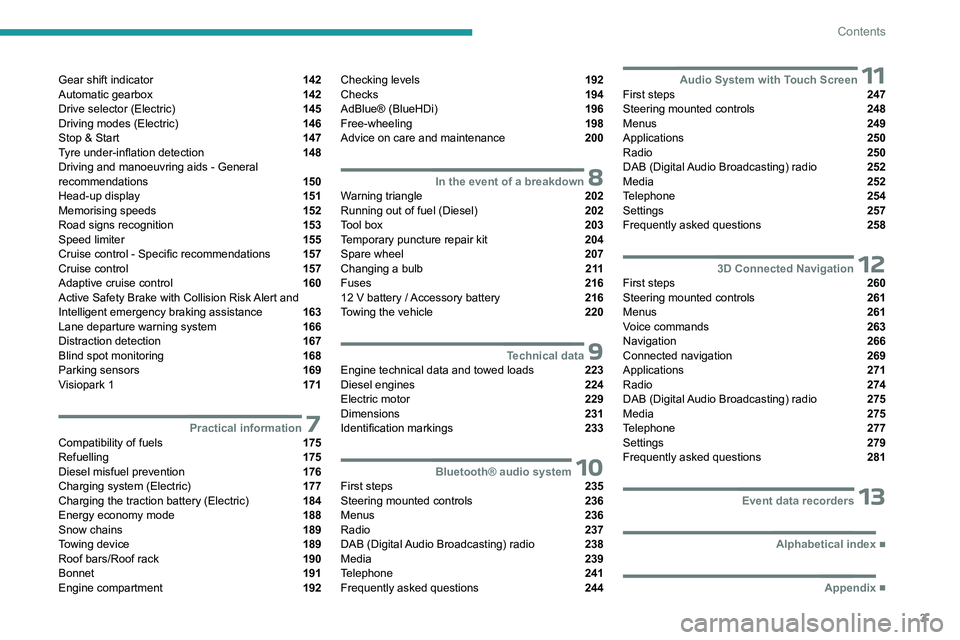
3
Contents
Gear shift indicator 142
Automatic gearbox 142
Drive selector (Electric) 145
Driving modes (Electric) 146
Stop & Start 147
Tyre under-inflation detection 148
Driving and manoeuvring aids - General
recommendations
150
Head-up display 151
Memorising speeds 152
Road signs recognition 153
Speed limiter 155
Cruise control - Specific recommendations 157
Cruise control 157
Adaptive cruise control 160
Active Safety Brake with Collision Risk Alert and
Intelligent emergency braking assistance
163
Lane departure warning system 166
Distraction detection 167
Blind spot monitoring 168
Parking sensors 169
Visiopark 1 171
7Practical informationCompatibility of fuels 175
Refuelling 175
Diesel misfuel prevention 176
Charging system (Electric) 177
Charging the traction battery (Electric) 184
Energy economy mode 188
Snow chains 189
Towing device 189
Roof bars/Roof rack 190
Bonnet 191
Engine compartment 192
Checking levels 192
Checks 194
AdBlue® (BlueHDi) 196
Free-wheeling 198
Advice on care and maintenance 200
8In the event of a breakdownWarning triangle 202
Running out of fuel (Diesel) 202
Tool box 203
Temporary puncture repair kit 204
Spare wheel 207
Changing a bulb 2 11
Fuses 216
12
V battery
/ Accessory battery 216
Towing the vehicle 220
9Technical dataEngine technical data and towed loads 223
Diesel engines 224
Electric motor 229
Dimensions 231
Identification markings 233
10Bluetooth® audio systemFirst steps 235
Steering mounted controls 236
Menus 236
Radio 237
DAB (Digital Audio Broadcasting) radio 238
Media 239
Telephone 241
Frequently asked questions 244
11Audio System with Touch ScreenFirst steps 247
Steering mounted controls 248
Menus 249
Applications 250
Radio 250
DAB (Digital Audio Broadcasting) radio 252
Media 252
Telephone 254
Settings 257
Frequently asked questions 258
123D Connected NavigationFirst steps 260
Steering mounted controls 261
Menus 261
Voice commands 263
Navigation 266
Connected navigation 269
Applications 271
Radio 274
DAB (Digital Audio Broadcasting) radio 275
Media 275
Telephone 277
Settings 279
Frequently asked questions 281
13Event data recorders
■
Alphabetical index
■
Appendix
Page 6 of 324
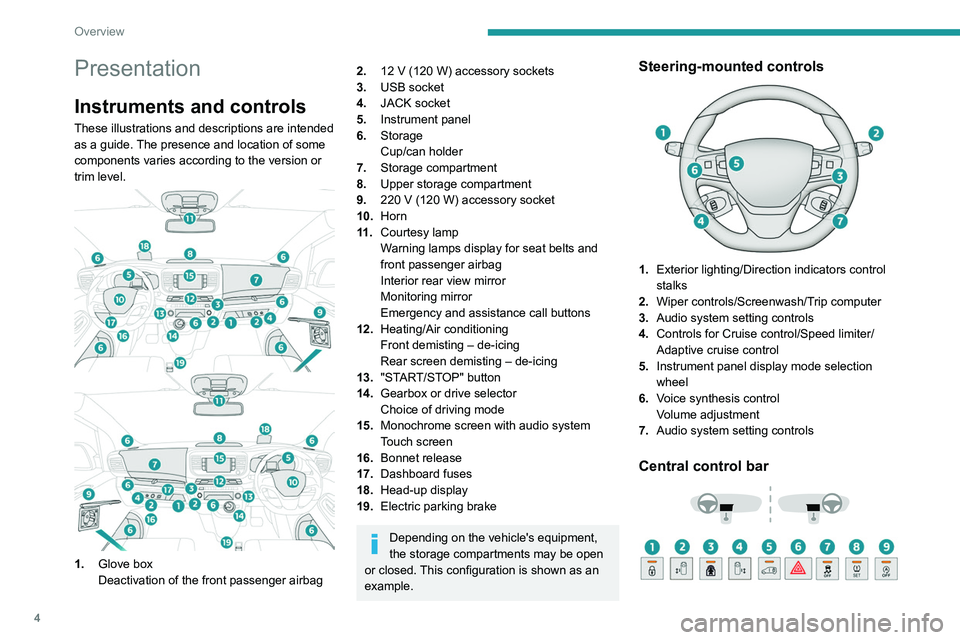
4
Overview
Presentation
Instruments and controls
These illustrations and descriptions are intended
as a guide. The presence and location of some
components varies according to the version or
trim level.
1.Glove box
Deactivation of the front passenger airbag
2.12 V (120 W) accessory sockets
3. USB socket
4. JACK socket
5. Instrument panel
6. Storage
Cup/can holder
7. Storage compartment
8. Upper storage compartment
9. 220
V (120 W) accessory socket
10.Horn
11
.Courtesy lamp
Warning lamps display for seat belts and
front passenger airbag
Interior rear view mirror
Monitoring mirror
Emergency and assistance call buttons
12. Heating/Air conditioning
Front demisting – de-icing
Rear screen demisting – de-icing
13. "START/STOP" button
14. Gearbox or drive selector
Choice of driving mode
15. Monochrome screen with audio system
Touch screen
16. Bonnet release
17. Dashboard fuses
18. Head-up display
19. Electric parking brake
Depending on the vehicle's equipment,
the storage compartments may be open
or closed. This configuration is shown as an
example.
Steering-mounted controls
1. Exterior lighting/Direction indicators control
stalks
2. Wiper controls/Screenwash/Trip computer
3. Audio system setting controls
4. Controls for Cruise control/Speed limiter/
Adaptive cruise control
5. Instrument panel display mode selection
wheel
6. Voice synthesis control
Volume adjustment
7. Audio system setting controls
Central control bar
Page 98 of 324
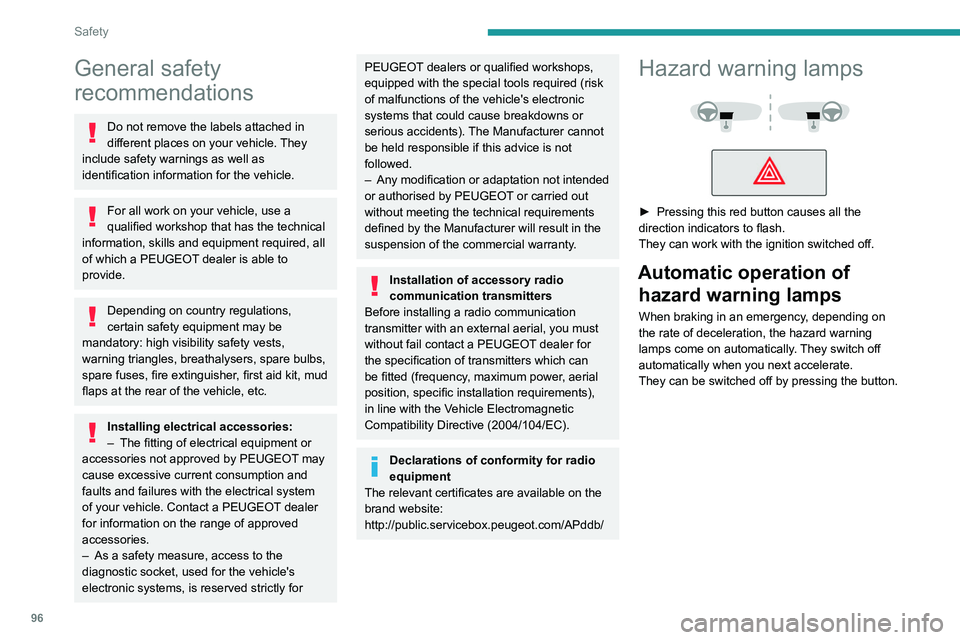
96
Safety
General safety
recommendations
Do not remove the labels attached in
different places on your vehicle. They
include safety warnings as well as
identification information for the vehicle.
For all work on your vehicle, use a
qualified workshop that has the technical
information, skills and equipment required, all
of which a PEUGEOT dealer is able to
provide.
Depending on country regulations,
certain safety equipment may be
mandatory: high visibility safety vests,
warning triangles, breathalysers, spare bulbs,
spare fuses, fire extinguisher, first aid kit, mud
flaps at the rear of the vehicle, etc.
Installing electrical accessories:
– The fitting of electrical equipment or
accessories not approved by PEUGEOT
may
cause excessive current consumption and
faults and failures with the electrical system
of your vehicle. Contact a PEUGEOT dealer
for information on the range of approved
accessories.
–
As a safety measure, access to the
diagnostic socket, used for the vehicle's
electronic systems, is reserved strictly for
PEUGEOT dealers or qualified workshops,
equipped with the special tools required (risk
of malfunctions of the vehicle's electronic
systems that could cause breakdowns or
serious accidents). The Manufacturer cannot
be held responsible if this advice is not
followed.
–
Any modification or adaptation not intended
or authorised by PEUGEOT
or carried out
without meeting the technical requirements
defined by the Manufacturer will result in the
suspension of the commercial warranty.
Installation of accessory radio
communication transmitters
Before installing a radio communication
transmitter with an external aerial, you must
without fail contact a PEUGEOT dealer for
the specification of transmitters which can
be fitted (frequency, maximum power, aerial
position, specific installation requirements),
in line with the Vehicle Electromagnetic
Compatibility Directive (2004/104/EC).
Declarations of conformity for radio
equipment
The relevant certificates are available on the
brand website:
http://public.servicebox.peugeot.com/APddb/
Hazard warning lamps
► Pressing this red button causes all the
direction indicators to flash.
They can work with the ignition switched off.
Automatic operation of hazard warning lamps
When braking in an emergency, depending on
the rate of deceleration, the hazard warning
lamps come on automatically. They switch off
automatically when you next accelerate.
They can be switched off by pressing the button.
Page 194 of 324
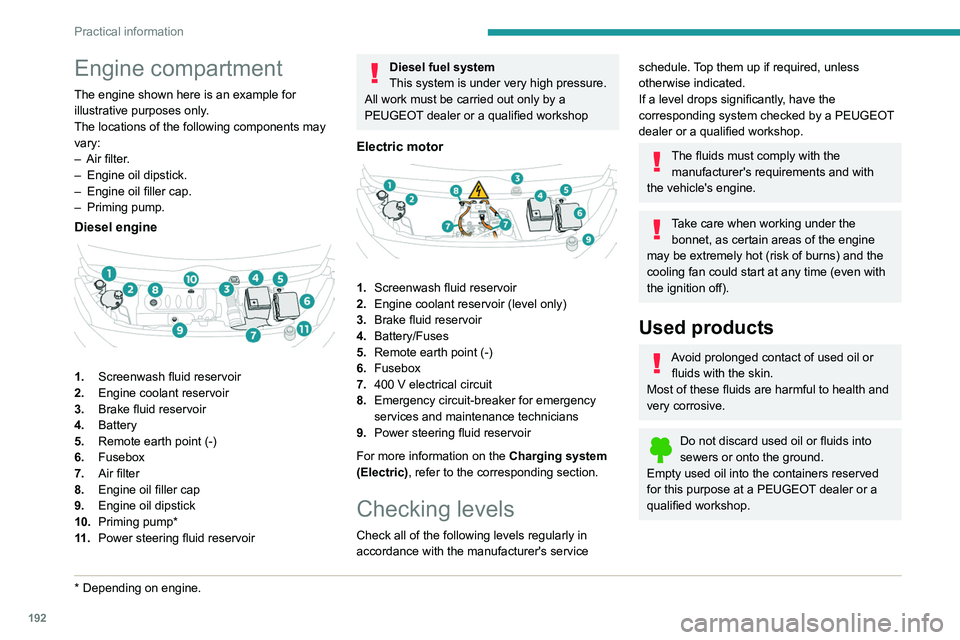
192
Practical information
Engine compartment
The engine shown here is an example for
illustrative purposes only.
The locations of the following components may
vary:
–
Air filter
.
–
Engine oil dipstick.
–
Engine oil filler cap.
–
Priming pump.
Diesel engine
1. Screenwash fluid reservoir
2. Engine coolant reservoir
3. Brake fluid reservoir
4. Battery
5. Remote earth point (-)
6. Fusebox
7. Air filter
8. Engine oil filler cap
9. Engine oil dipstick
10. Priming pump*
11 . Power steering fluid reservoir
* Depending on engine.
Diesel fuel system
This system is under very high pressure.
All work must be carried out only by a
PEUGEOT dealer or a qualified workshop
Electric motor
1. Screenwash fluid reservoir
2. Engine coolant reservoir (level only)
3. Brake fluid reservoir
4. Battery/Fuses
5. Remote earth point (-)
6. Fusebox
7. 400
V electrical circuit
8. Emergency circuit-breaker for emergency
services and maintenance technicians
9. Power steering fluid reservoir
For more information on the Charging system
(Electric), refer to the corresponding section.
Checking levels
Check all of the following levels regularly in
accordance with the manufacturer's service
schedule. Top them up if required, unless
otherwise indicated.
If a level drops significantly, have the
corresponding system checked by a PEUGEOT
dealer or a qualified workshop.
The fluids must comply with the manufacturer's requirements and with
the vehicle's engine.
Take care when working under the bonnet, as certain areas of the engine
may be extremely hot (risk of burns) and the
cooling fan could start at any time (even with
the ignition off).
Used products
Avoid prolonged contact of used oil or fluids with the skin.
Most of these fluids are harmful to health and
very corrosive.
Do not discard used oil or fluids into
sewers or onto the ground.
Empty used oil into the containers reserved
for this purpose at a PEUGEOT dealer or a
qualified workshop.
Page 292 of 324
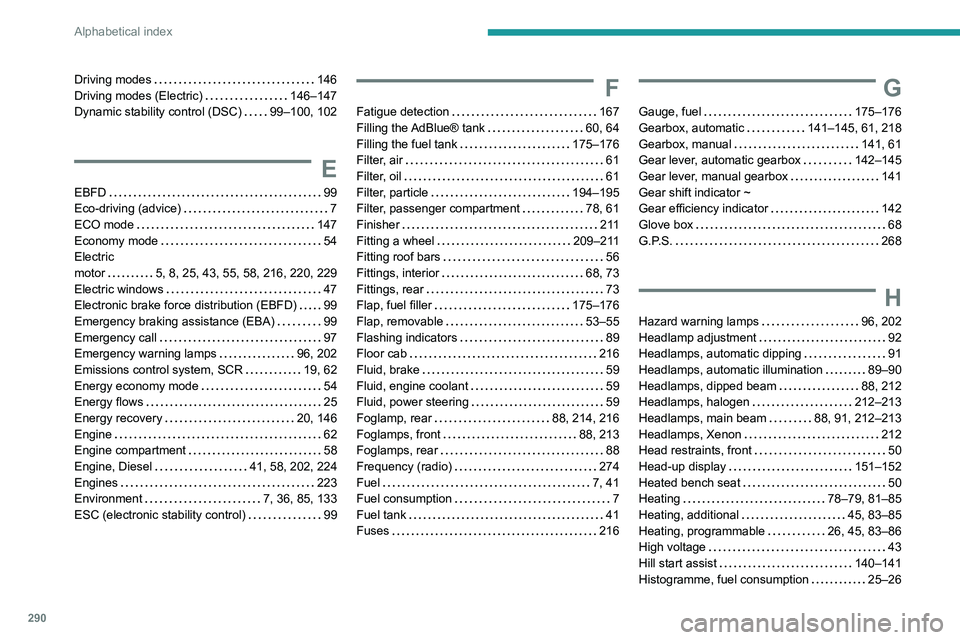
290
Alphabetical index
Driving modes 146
Driving modes (Electric)
146–147
Dynamic stability control (DSC)
99–100, 102
E
EBFD 99
Eco-driving (advice)
7
ECO mode
147
Economy mode
54
Electric
motor
5, 8, 25, 43, 55, 58, 216, 220, 229
Electric windows
47
Electronic brake force distribution (EBFD)
99
Emergency braking assistance (EBA)
99
Emergency call
97
Emergency warning lamps
96, 202
Emissions control system, SCR
19, 62
Energy economy mode
54
Energy flows
25
Energy recovery
20, 146
Engine
62
Engine compartment
58
Engine, Diesel
41, 58, 202, 224
Engines
223
Environment
7, 36, 85, 133
ESC (electronic stability control)
99
F
Fatigue detection 167
Filling the AdBlue® tank
60, 64
Filling the fuel tank
175–176
Filter, air
61
Filter, oil
61
Filter, particle
194–195
Filter, passenger compartment
78, 61
Finisher
2 11
Fitting a wheel
209–211
Fitting roof bars
56
Fittings, interior
68, 73
Fittings, rear
73
Flap, fuel filler
175–176
Flap, removable
53–55
Flashing indicators
89
Floor cab
216
Fluid, brake
59
Fluid, engine coolant
59
Fluid, power steering
59
Foglamp, rear
88, 214, 216
Foglamps, front
88, 213
Foglamps, rear
88
Frequency (radio)
274
Fuel
7, 41
Fuel consumption
7
Fuel tank
41
Fuses
216
G
Gauge, fuel 175–176
Gearbox, automatic
141–145, 61, 218
Gearbox, manual
141, 61
Gear lever, automatic gearbox
142–145
Gear lever, manual gearbox
141
Gear shift indicator ~
Gear efficiency indicator
142
Glove box
68
G.P.S.
268
H
Hazard warning lamps 96, 202
Headlamp adjustment
92
Headlamps, automatic dipping
91
Headlamps, automatic illumination
89–90
Headlamps, dipped beam
88, 212
Headlamps, halogen
212–213
Headlamps, main beam
88, 91, 212–213
Headlamps, Xenon
212
Head restraints, front
50
Head-up display
151–152
Heated bench seat
50
Heating
78–79, 81–85
Heating, additional
45, 83–85
Heating, programmable
26, 45, 83–86
High voltage
43
Hill start assist
140–141
Histogramme, fuel consumption
25–26